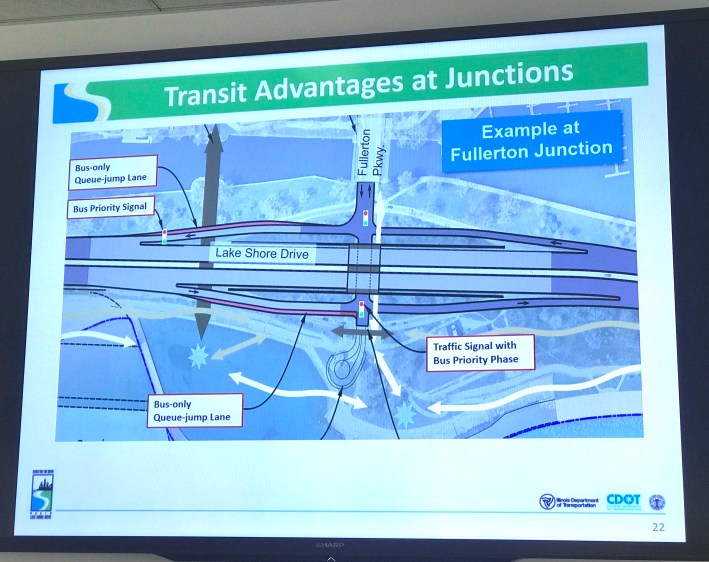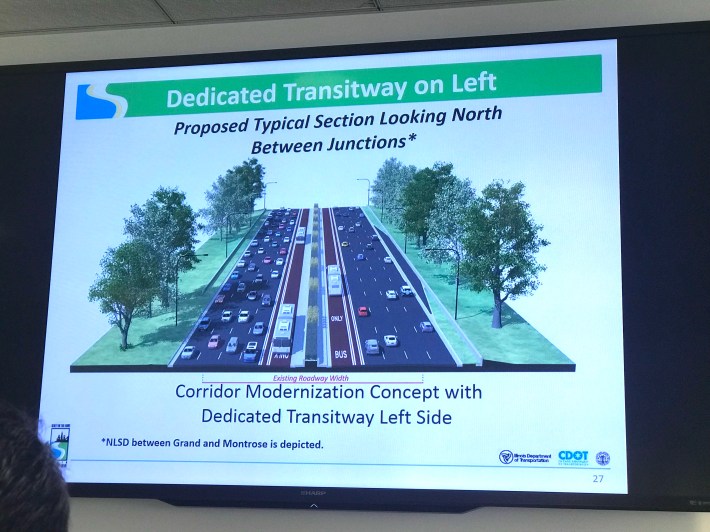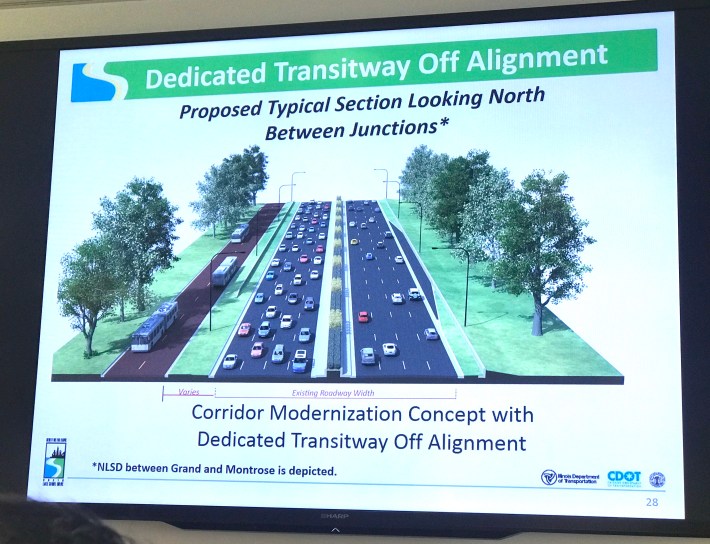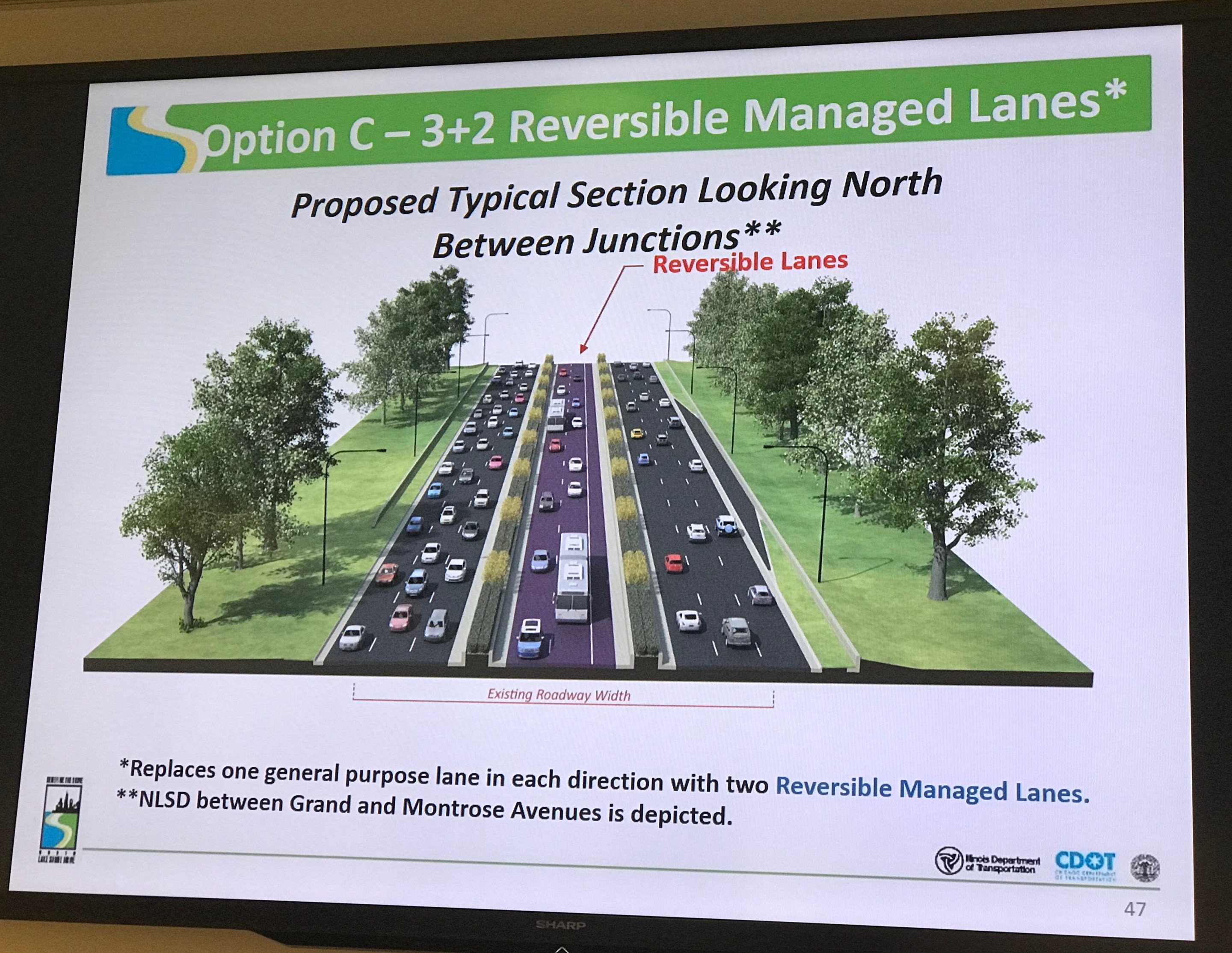Hot off the heels of July’s public meeting, the Illinois Department of Transportation finally lifted the curtain off its Transit and Managed lanes concepts for the North Lake Shore Drive reconstruction project on October 16, 2017, at the CMAP offices. Unfortunately, the results are a mixed bag of good ideas held back by an apparent desire to maintain the car-centric status quo. View the presentation from Monday's event here.
The meeting started out well enough with the presentation of some relevant data from the survey taken at the last meeting. Out of the almost 2,500 responses, a whopping 41 percent of participants said they didn’t own a car, in massive contrast to the citywide car-less rate of 27 percent of households and Cook County rate of only 18 percent of households without vehicles. Notably, out of about 1,000 responses, 65 percent of respondents said they would switch to the bus if improvements were made to both speed and reliability. The study acknowledges this, noting that several factors have significant impacts on bus service. The example given was a typical CTA #147 Outer Drive Express trip with a quick eight-minute travel time at 6 a.m, that bumps up to 18 minutes at 8 a.m. due to rush-hour congestion. The worst travel time for this trip was a 31-minute on a “bad day,” or roughly a day every two weeks, something recently noted by Transport Politic blogger Yonah Freemark.

The transitway alternative themselves can be broken down into four categories. The first one can apply regardless of the final alignment, IDOT calls this “Transit Advantages at Junction.” In other words, at specific junctions buses would have access to both a new queue-jump lane as well as priority signals. The second option is bus-on-shoulder, a strategy that's been successfully deployed in both the Chicago area and Minneapolis. However this might be challenging to implement on NLSD due to junction proximity and other vehicles taking up the shoulder lane. In addition, buses are only allowed to go 15 mph over the speed of traffic with a maximum of 35mph.
The third idea was a transitway on the inside of NLSD. This would minimize conflicts with cars coming on and off the drive as well as allow buses to hit a maximum speed of 45mph. The final proposal is an entirely separated off-alignment transitway that would otherwise be the ideal solution but unfortunately has several flaws that I’ll touch on later. IDOT also noted that dedicated alignment could be built in a way to accommodate future light rail, but nothing was committed to.

Unfortunately, all of these scenario contain a major drawback, the necessity of expanding the width of the drive by adding a lane. While the Chicago Metropolitan Agency for Planning has projected transit ridership to grow, they also predict that the amount of driving will stay the same, making it a harder to make the case for the conversion of existing lanes. Of course, that's something of a self-fulfilling prophesy: If we continue to make the same amount of road space available for driving, that will facilitate the same levels of car use.
The alternative that IDOT is promoting is managed lanes. The route of these roads is similar to the median transitway alternative, only with more dedicated onramps for drivers and buses along with a few ramps for exclusive use by buses. The thinking behind this approach is that because drivers would technically still have access to the lanes, theoretically LAke Shore Drive would continue to have car capacity similar to exists now while speeding up the buses. IDOT is also emphasizing that a fee or toll would probably need to be charged to keep the lanes free flowing, an idea that would require new state legislation. The city of Chicago explored this idea back in 2011, but ultimately the proposal didn’t go anywhere.
After that, attendees broke up into our groups and to look at maps. The table I was at started with the managed lanes with the presenter pointing out that in this scenario the ramps at Addison would only interact with the new managed lanes. Interestingly our table presenter mentioned that in the models they had run so far, every bus route running at two-minute headways at peak or a bus every 40 seconds in some sections. The presenter also tried to play down concerns that the new split design over the intersections to accommodate the center on/off ramps were too highway-like, but conceded that the viaducts would increase in size under this plan.

Later we looked at the off-alignment transitway. While this should be the perfect solution, several significant flaws keeping it from reaching its full potential. The central issue is the design philosophy behind the ROW, which is to maintain current service. In other words, instead of a proper BRT route, this would only be used as a dedicated space for existing routes. Any stations would need to have some bypass lane making an already tight ROW even tighter. These constraints would also mean dramatic changes to the layout of the drive with a tunnel at Irving Park while the busway would be stuck at-grade. Meanwhile the proximity of Montrose and Lawrence meant that a considerable chunk of the busway would need to be in a trench similar to the McCormick Place Busway. To say this is all less than ideal is an understatement and I do hope IDOT and the CTA start to rethink how the bus routes interact with NLSD, present and future.
To wrap up the meeting we got to hear a quick update on the Lakefront Trail and that the next task force meeting would be focusing more heavily on that aspect of the project along with a look at the following round of alternatives. The meeting should take place sometime in early 2018 while the next one for the Northern Terminus Study should take place sometime in late 2017 or early 2018. As always, the project managers are still accepting feedback via their website and encourage everyone to send some their way.





